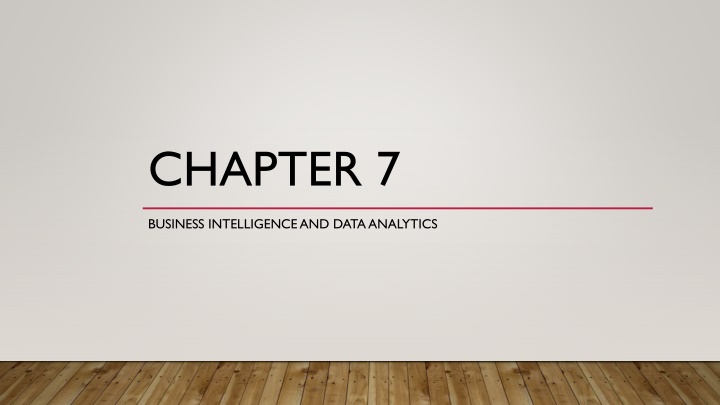
Business Intelligence and Decision Making Process
Explore the phases of decision making, differentiate between structured and unstructured problems, grasp the concept of business intelligence, and learn about the risks associated with Business Intelligence. This chapter delves into the intricacies of making informed decisions in a business environment, emphasizing the importance of data analysis and intelligence in strategic decision-making processes.
Download Presentation

Please find below an Image/Link to download the presentation.
The content on the website is provided AS IS for your information and personal use only. It may not be sold, licensed, or shared on other websites without obtaining consent from the author. If you encounter any issues during the download, it is possible that the publisher has removed the file from their server.
You are allowed to download the files provided on this website for personal or commercial use, subject to the condition that they are used lawfully. All files are the property of their respective owners.
The content on the website is provided AS IS for your information and personal use only. It may not be sold, licensed, or shared on other websites without obtaining consent from the author.
E N D
Presentation Transcript
CHAPTER 7 BUSINESS INTELLIGENCE AND DATA ANALYTICS
CHAPTER OBJECTIVES List and explain the phases in decision making; Articulate the difference between structured and unstructured decision making; Understand the business intelligence and key components of a business intelligence; Identify the risks of Business Intelligence
THE DECISION MAKING PROCESS A decision must be made whenever more than one possible action is available It can be difficult to make decisions when many reasonable alternatives are present In business, there may be dozens, hundreds, or even millions of different courses of actions available to achieve a desired result
THE DECISION MAKING PROCESS Intelligence phase: collect facts, beliefs, and ideas Design phase: design the method for considering the collected data, to reduce the alternatives to a manageable number Choice phase: select an alternative from the remaining choices
STRUCTURED PROBLEM Structured problem: It is the problem in which an optimal solution can be reached through a set of steps Algorithm: a set of steps in order to solve a problem Parameters: a set of data that are used in an algorithm
UNSTRUCTURED PROBLEM Unstructured problem: It is the problem that there is no algorithm which leads to an optimal solution because Lack of enough of information A large number of factors that have impact to the problem There is too many uncertainty Examples of unstructured problems Stock market prediction Company performance in next ten years
SEMI-STRUCTURED PROBLEM Semi-structured problem: It is the problem that is neither fully structured nor unstructured. People face semi-structured problems almost everyday in many different industries. The goal is to select the one alternative that will bring the best outcome.
DECISION SUPPORT SYSTEMS Decision support systems (DSS): a computer-based information system designed to help knowledge workers select one of many alternative solutions to a problem. DSSs can help enterprise to: Increasing market share Reducing operational costs Increasing profitability Achieving business goals
DECISION SUPPORT SYSTEMS Most DSSs consist of three major components Interactive module Enter a request in a convenient way View the results Data management module Search a large amount data Model management module Process data using appropriate model
INTERACTIVE MODULE Interactive module: the component of DSS that allows user interaction with the problem Allows the user to select a model and data Allows the user to change parameters Visualizes the results in textual, tabular, or graphical format
DATA MANAGEMENT MODULE Data management module: a database or data warehouse that provide data for the intelligence phase Accesses the data Provides a way to select data by specified criteria
MODEL MANAGEMENT MODULE Model management module: turns data into useful information Models are used for output often based on mathematical algorithm Example of model management module A linear regression model is often used to give a best-fit linear relationship between two variables
DECISION SUPPORT SYSTEMS IN ACTION Estimate sales in business Analyze customer behavior Determine loan amounts
EXPERT SYSTEMS Expert systems: emulates the knowledge of a human expert To solve problems To make decisions in a relatively narrow domain Domain: a specific area of knowledge Purpose is to make experts with unstructured knowledge available to novices Expert Systems are part of Artificial Intelligence (AI) research which focuses on methods and technologies that emulate how humans learn and solve problems.
ARTIFICIAL INTELLIGENCE Neural network: a program that emulates how the human brain works Used by more sophisticated expert systems Constructed with a set of rules Beneficial in detecting fraudulent transactions and claims Knowledge base: used by an expert system Collection of facts and relationships Built as a series of IF-THEN rules
EXPERT SYSTEMS IN ACTION Medical diagnosis Help doctors with the diagnosis of symptoms and treatment advice Assist with health information management Credit evaluation Analyze financial reports submitted with credit applications
BUSINESS ANALYTICS AND INTELLIGENCE Business Analytics (BA): the extensive use of data, statistical and quantitative analysis, explanatory and predictive models, an fact-based management to drive decisions and actions. Business Intelligence (BI): the next level of BA and its practices involve data visualization and reporting for understanding what happened and what is happening. This is done by charts, tables, and dashboards to display, examine, and explore data.
PROCESS OF DEVELOPING BI The process of developing BI involves acquiring, analyzing, and publishing data with an objective of discovering patterns in data that will inform a business person.
ACQUIRING Acquiring includes Obtain data Cleanse data Organize and relate data Catalog data
ANALYZING Analyzing include Reporting (OLAP- Online Analytical Processing) Data mining (Cluster, Regression, Associate analysis, Market basket analysis )
PUBLISHING Publishing includes Visualization (Pivot Table in Excel, Tableau, SAP analytics cloud)













